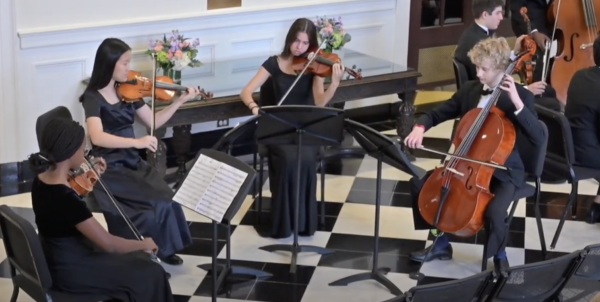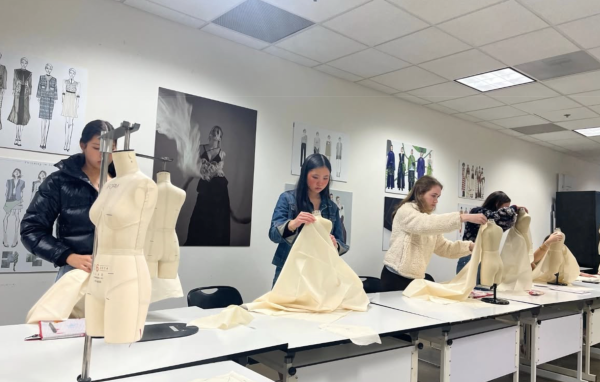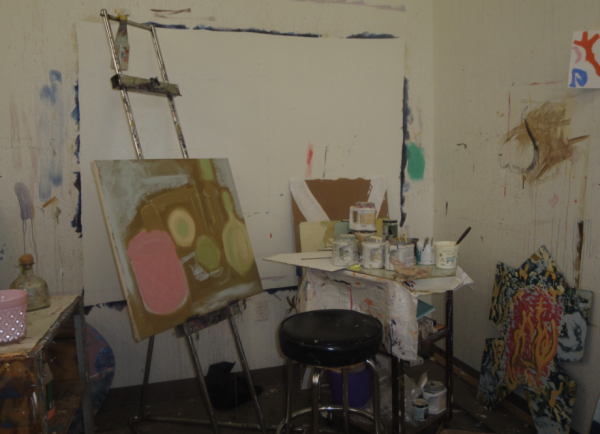AP Art students adjust to changes in curriculum
It is certainly the year of change for students at Westminster. As the student body has been adjusting to the cottages, construction on campus, and as always, a new freshman class, the AP art students have even more adjusting to do. Joining the ranks this year are changes in the curriculum of the AP art classes, such as 2D design, 3D design, and drawing and painting.
In past years, the final portfolio, which is submitted for an AP score, has consisted of a breadth, a concentration, and a quality. The breadth section consists of 12 pieces that show a wide range of skills, mediums, approaches, and ideas. The concentration is a group of 12 pieces that all follow a central idea or theme. Finally, the quality section is selected from the original 24 to form a set of five pieces that are considered to be the best. While the concentration and breadth are submitted and graded electronically, the quality is mailed somewhere in the country, to a location where the AP readers will look at those pieces and give them a grade.
However, there have been some significant changes to the curriculum this year. First, there will be no breadth. Instead, Students will submit 15 pieces as a concentration.
“Part of the thinking is, to have breadth go away, it opens you up to having more leeway, flexibility in the curriculum, but also in the topic chosen,” says Benjamin Steele, who teaches some of the AP art classes and is also an AP reader. “Partly the idea is that it’s not as much a project anymore, as something that you’re investigating over time.” According to Steele, Westminster had already begun the shift to teaching this way, assigning projects that are meant to push one idea in many different directions. So, he says, the change probably won’t be as dramatic as in other art programs.
“I like [the changes], and I think that definitely not having this other section hanging over you is helpful, but it’s also the way you’re asking to present it is different,” says Steele. “Whereas in the past, 12 images was understood much more like 12 pieces… now you’re really being encouraged to document your process and your thinking.”
For example, senior Max Graves, who took AP art last year, did a painting in which he used a mop and took pictures of him painting with that as process shots.
“I dipped a mop in a bucket of paint and painted on this massive board, which became my concentration” says Graves. “The 15 [pieces] are good, because then you get sort of that extra legroom. Like you could do 12, and then one process shot and two detail shots and still have a complete [concentration].”
“The exam is much more like an actual test now because they’re testing one thing, as opposed to just testing your abilities, which is interesting,” says senior Woods Curry. Curry is one of two students, along with Graves, who were the only juniors to take AP art last year. They’ll be retaking the same class this year and directly experience the new changes. Along with the 15 piece concentration, students will write a concentration statement talking about the concentration and what it means, to be read and graded by the AP readers. According to Mr. Steele, AP had always required reading, but the difference this year is that it will actually be graded as a part of the AP score.
“I really like how they added the concentration statement part of it, especially if you want to do a concentration that’s maybe out of the box, you can write about it and get them to figure out what it is. Which is important, because otherwise you’d be looking at art, and you’d be like, I’m gonna guess what this is,” says Curry, whose concentration is, so far, a bit out of the box.
“… it felt like, more than anything else…a relief of pressure, like in terms of this idea of time,” says Steele. Students seem to be relieved that they don’t have to worry about making 24 pieces, and instead can focus on developing the ideas behind their concentrations.
“But I will say the breadth was also a chance to submit art that you’ve done maybe freshman year, or sophomore year, or junior year, just because it’s everything you’ve ever made is fair game, so that’s taken away…. I’m excited for it though, it’ll be interesting,” says Curry. Graves says, “I kind of like [the changes] like it used to be 24 pieces, which is a lot.”
In order to give students a chance to start thinking about their concentrations, they were assigned summer work. The work was to create two pieces or sketchbook pages that explored an idea or theme that the student might want to build their concentration around.
“Every student, at the end of their AP or portfolio year, has started a concentration idea. So the summer is really a chance to kind of reflect on that… you’re either doing a second response to that same idea or shifting to and developing a different theme” says Steele. “You can take advantage of that time where you have that free mind, and mental space, and can really make a push and realize what you’re about and what you want to be doing.”
Graves used the summer to plan concentrations over a few sketchbook pages, which included some writing, drawing, and pictures that went with his idea. In one of them, he was thinking about scale and miniature objects, which he said was his favorite idea. This year, his concentration might be based on those sketchbook pages, but Graves says, “sometimes it just comes to you.”
“Everyone’s (concentration) is very unique, so the goal is to figure out a unique idea and portray it in your art,” says Curry. Over the summer, he made two pieces that are indeed very unique. His pieces are about a fungus called the cordyceps fungi, whose spores grow inside of insects and sprout through their nervous system.
“I wanted to play with this idea of making something dead beautiful, and I also just think it’s really cool how nature takes its own forms and makes them into something new.”



